What are PROGRESSIVE WEB APPS? Find the Best PWA Developers
Except if you’ve been living under the stone, you’ve likely known about PWAs or Progressive Web Apps. It’s an interesting issue right now since its help is expanding in various platforms, and real organizations are choosing to take a shot at PWA variants of their web applications including Lyft, Twitter, NASA, Starbucks, and a lot more.
Progressive Web Apps have blasted onto the mobile web scene and is advancing the way web applications used to be. The constant endeavors for serving better to users and shedding the imperfections have brought about this lightweight yet include rich web applications.
As a leading Progressive Web Application Development Company (ChromeInfotech), we provide robust progressive, hybrid and Mean-Stack Development solution. We are also integrating Map SDK and Chat API in your mobile application along with geofencing or geolocation API.
If you are looking to make your app success or you need to get funded in your app idea, you must get in touch with us. We will be helping our client from scratch, and Our progressive web app developers will provide the best solution that suits their needs.
What is Progressive Web App?
Progressive Web Apps additionally called PWAs are the web applications that look and feel merely like a native mobile application. It deals with any program whether it be opera, chrome, or Samsung web browser and the users can easily download from the application store.
Just click on the link and PWA will be installed on your phone.
Much the same as a native mobile application, a PWA is shown on the homepage, in the application drawer, sends message pop-ups and integrate into framework settings.
It increased more consideration when Apple declared Service Worker as well as Web Manifest help for Safari. Microsoft conveyed PWAs to the Windows store, and Chrome has trial PWA support for every one of the platforms.
The Idea of Progressive Web Apps
Google thought about best 1000 mobile applications versus top 1000 cellular application properties (web) to research user engagement and downloads. The consequences of the correlation demonstrated an extraordinary dissimilarity in user behavior.
As per the research, mobile web reach is higher than the native application reach. It was 11.4 million real visitors every month as compared to 4 million guests.
Though the details of user engagement with services demonstrated that users would, in general, invest more energy in native mobile applications contrasted with the mobile web, it was typical of 188.6 minutes on the application against 9.3 minutes on the internet.
Thus, the thought was clear. It needs to give a native application like drawing in involvement to users on the mobile web. Along these lines, Progressive Web Apps were created to convey extraordinary user experience on the internet.
The preparation works admirably of clarifying how everything cooperates, and furthermore brings you straight into the code.
Why Progressive Web App or PWA?

The web is an independent Operating System, which is broadly reachable and is the highest platform on the web. We see that users invest much time in native applications than on the internet.
For what reason is this so?
The fundamental reason is the smooth understanding and engagement native applications give. Should we convey these highlights to Web Apps?
That would mean the mix of the simple entry and reach of the Web (3x when contrasted with native applications), alongside the vivid experience of native apps.
As per the Shishir:
Just websites which took all the right nutrients
These nutrients are merely highlights of native applications that we add on to Web Apps to defeat the two universes. Apps that you can get to straightforwardly from the Web, yet work efficiently and quicker, are installable, and may even have noticed.
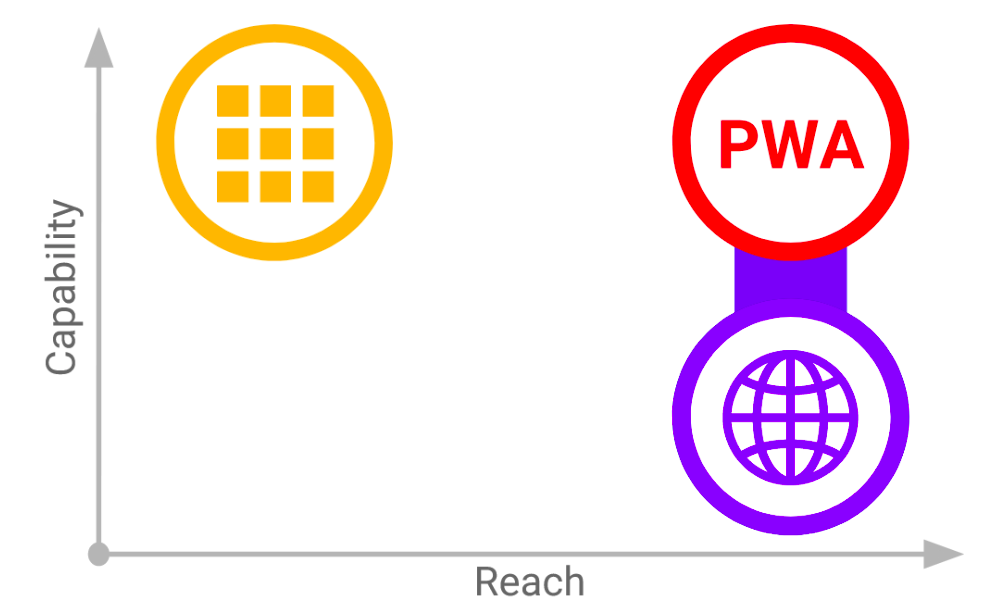
What makes Progressive Web Apps what they are?
The key highlights as per to the Google:
- Reliable: Offline-first, which means it ought to give interfaces even in poor or no web association. In any case, this additionally doesn’t imply that the application ought to almost certainly work when disconnected, but instead gives undisrupted service in all system conditions.
- Fast: Instant-stacking, and smooth encounters even on loading content.
- Engaging: Should give a vivid ordeal, proportionate to that of a native application. Can have Push warnings, Web Payments, or Credential the executives, etc. Being installable is likewise a key component here.
However, these are merely concepts — how do we consider execution from a functional perspective? find an easy way to understand here:

So we should get into this one by one:
Service Worker
It’s a JavaScript document that runs independently from the principle program string out of sight, catching system demands, storing assets, and giving a base to different APIs including pop-up messages, foundation adjust, and reserving.
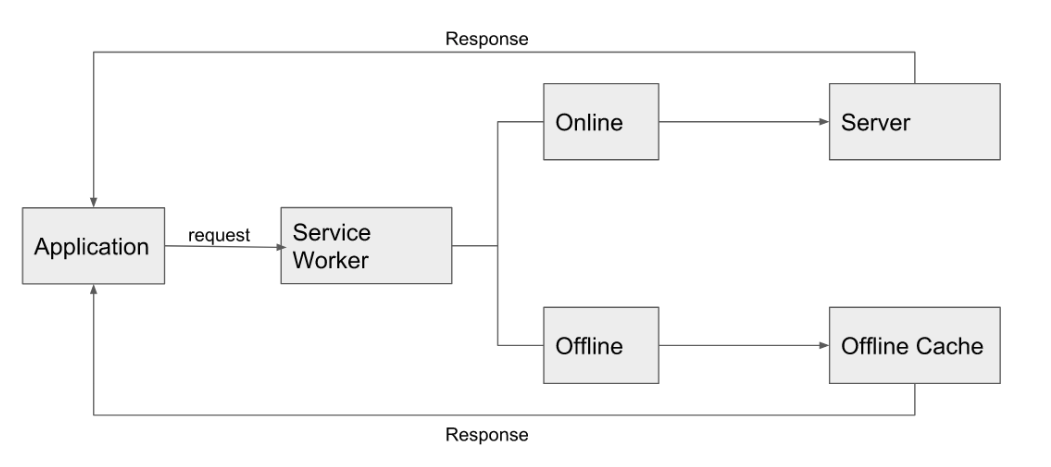
The capacity of service specialists to run independently out of sight helps give a great deal of usefulness to the application notwithstanding when shut, providing an increasingly native application like and drawing in involvement.
It likewise helps in making the application disconnected first as it goes about as an intermediary between the server and application.
A prologue to service laborers can get here, and Google has a couple of partners publicly released in their Service Worker Toolbox.
HTTPS
Hypertext Transfer Protocol Secure is an adjustment for secure HTTP correspondences utilizing SSL or TLS encryption. In any case, how about we not get into that — instead, we’ll go into the motivation behind why it’s essential.
Other than the way that PWAs are relied upon to be exceedingly secure, service laborers that they use can block organize asks for and adjust reactions.
This can be misused effectively to cause genuine assaults. There are numerous services which help you get your site an SSL certificate such as LetsEncrypt and SSLforfree.
Web App Manifest
A JSON record gives the insight about how the application should look in the home screen, on the web, etc. It very well may be utilized to include a subject shading, symbols for the home screen, and a sprinkle screen to give some examples.
But, the question is –
Why Are Progressive Web Apps the Future of Web Development?
Yes, the PWA is the future of app development. “The key is to grasp interruption and change early. Try not to respond to it decades later. You can’t battle innovation.”
Recently, there’s been a great deal of buzz around PWAs with many asserting it to be the fate of web development, particularly as far as mobile gadgets.
At its center, a Progressive Web App (PWA) is a web application that utilizes current web methods to convey a native application like involvement to users.
These are web applications with the following upgrade to actualize highlights like storing, foundation synchronize, and pop-up messages.
Even though PWAs have been around for over two years now, the reaction is very disappointing.
Barely any enormous players have received this logic. However, most haven’t grasped it. Chrome and Mozilla are maybe the best programs to try out your PWAs as Apple is yet to get into this stuff.
Why it bodes well to utilize PWA
As per the research, a regular user invests 80% of his whole energy in applications on just three of his applications.
Alternate applications sit inactive for the more significant part of this tedious a valuable segment of the memory. Also, it costs around multiple times to build up an application as opposed to making a website for the equivalent.
The expense can get a lot higher if you intend to create and keep up separate code bases for various platforms like Android, iOS and the web.
Native App features that PWAs can use
- Push notifications
- Full Screen
- Offline working
- The splash screen is supported offering it a more app-like feel
PWAs can make utilization of a lot increasingly such highlights. The above focuses are to give you a trace of what PWAs can do. Notwithstanding, there are some customary highlights that only native applications appreciate starting at now.
Native App features that PWAs Not Able to Use
- No or very prohibitive access to various equipment sensors
- Alarms
- Phonebook Access
- Modifying System Settings
PWAs are developing very rapidly, and we love to see these highlights come to action quite soon.
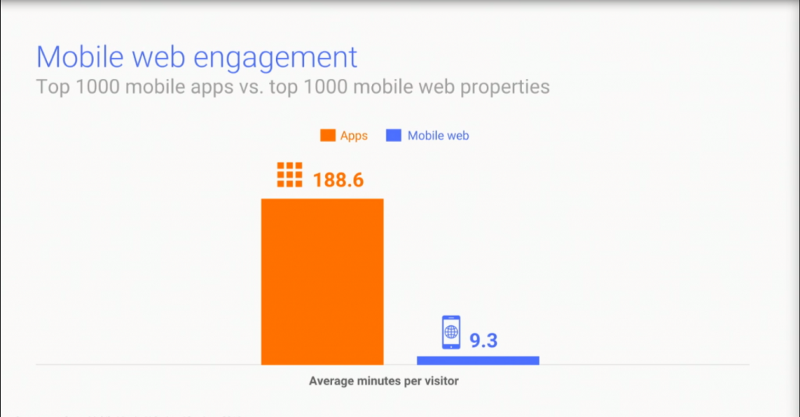
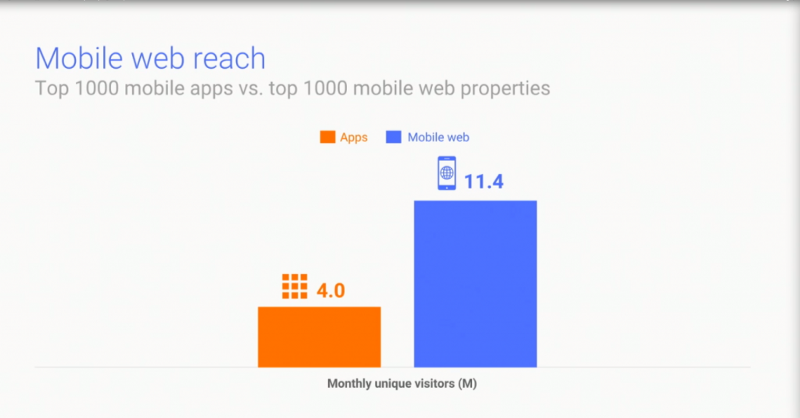
Advantages of PWAs
-
Responsive
Progressive Web Apps are exceptionally sensitive. They auto modifies the format as indicated by the gadget. In this way, regardless of whether it be a mobile, tablet, workstation or work area, PWAs will fit any device.
-
Highly Secure
PWAs are progressively secure contrasted with conventional web applications since they are served continuously using HTTPS. This guarantees the application can is carefully designed and can’t be vandalized.
-
Reliable Despite Network Flaws
One can depend on Progressive Web Apps notwithstanding when the system is weak as it can even work disconnected. This is conceivable through service specialist, a kind of web laborer. Konga, a main online business website in Nigeria figured out how to decrease 92% of the user information used because of its Progressive Web App.
-
Looks and Feels Just Like a Native App
The user won’t see any contrast between PWA and the native application. It precisely closely resembles a native application and even gives comparable highlights like the pop-up message, coordination with the framework, show symbol on the home screen and application cabinet, and so forth.

-
Installation
Influencing the user to introduce your application from the store can be a genuine annoyance. With a PWA the user can install the app with only one tap. This frictionless installation gives users a chance to appreciate service as opposed to establishing the cumbersome native use.
-
Easy Updates
A standout amongst the most stunning highlights of PWA is that it is anything but challenging to refresh. Since no application store functions as a middle person, your users can appreciate the updated application when you have updated it from your side.
-
Lightweight
Thus, PWAs are coming with astonishing highlights; they are incredibly lightweight. Contrasting Pinterest’s PWA and it’s Android and iOS application, it is only 150KB against 9.6MB and 56MB individually. Charmingly lightweight. Is it safe to say that it isn’t?

Difficulties
-
Browser Support
Though PWAs work flawlessly on most of the popular browsers such as Chrome, Opera and Samsung Internet, it is still unsupported in browsers like Sa Well, PWAs work faultlessly on the vast majority of the famous programs, for example, Chrome, Opera and Samsung Internet, it is as yet unsupported in applications like Safari.
-
Device Support
PWAs work immaculately on the vast majority of the Android gadgets. However, it is as yet unsupported with iOS gadgets. In any case, recognizing the potential and notoriety of PWAs, it is guessed that Apple is taking a shot at to make it accessible on iOS as well.
-
Hardware Functionality
There is a rundown of equipment functionalities that are as yet unsupported with PWAs. However, with the progressing time, numerous equipment functionalities have been made accessible just like a native application.
-
Groundbreaking Changes
The concept of PWA sounds fascinating; however, has it included any value to the companies?
Well, the answer is yes. PWAs have proven the success in the elevating performance, reach as well as user engagement. Here are a few instances and case studies from Google.
Twitter Lite

Twitter has embraced PWA innovation to improve mobile engagement and diminish the information use of its users. The web-based social networking monster has 328 million month to month dynamic users all around the world, among which 80% are mobile users.
They needed to serve quicker service, lower data utilization, give a strong, dependable and all the more captivating background to the users and consequently created Twitter Lite Progressive Web App.
This PWA has mostly lived up to their desires, and the accompanying outcomes have watched.
Results
- 75% increase in Tweets sent
- 65% increase in pages per session
- 20% decrease in bounce rate
- Decreased data consumption approx. 70% by optimizing the images.
So, the next example is –
BookMyShow
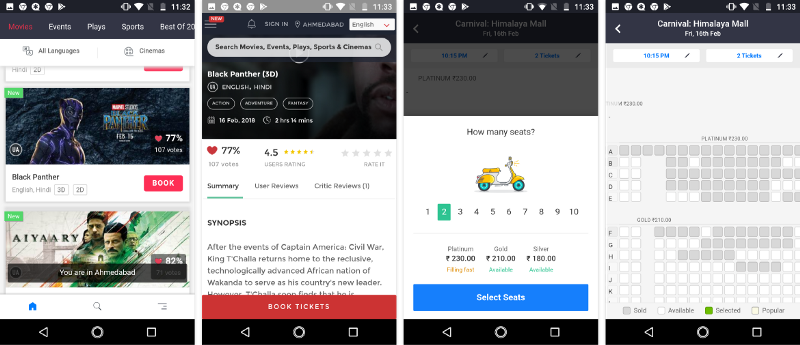
Since the release of our PWA, we’ve seen an exponential increment in free change rates. The PWA helped us interface with more individuals on mobile — and it’s mobile users who make up most of our general group of onlookers.
BookMYShow is the most prominent web-based ticketing firm in India with over 50+ million month to month guests. They saw an 80+ % help in buying tickets after creating the Progressive Web App for the mobile web.
Results
- BookMyShow has watched 80%+ increment in their transformation rates.
- The PWA takes under 2.94 seconds to stack and empowers checkout inside 30 seconds.
- The size of the PWA is 54x littler than the Android application and 180x littler than the iOS app.
After this, let me tell you the next one –

The picture sharing simple communication website understood that their moderate web experience just figured out how to change over 1% of users into recruits, logins or native application introduces.
To build this rate, they chose to create PWA for their mobile web. It took three months to manufacture the PWA Pinterest, and the result prompted a few upgrades for their business.
Results
- Average time spent has expanded by 40%
- User-created Ad income is up by 44%
- Ad click-throughs expanded by 50%
- The center user engagement raised by 60%
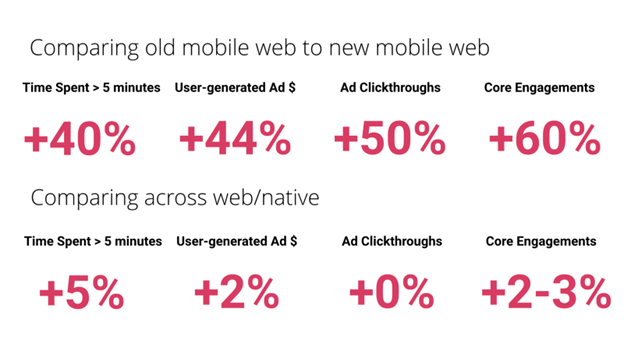
Now, let me tell you the next one which is –
Forbes

Forbes, an American business magazine is a momentous name in media. They created PWA to build user engagement.
It enabled them to take into account the news and data as indicated by the user’s inclination and inform them through message pop-up.
PWA has made its mobile web experience quicker customized, and lovely.
Results
- An increment in session per user have seen by 43%
- Ad perceptibility has expanded up to 20%
- The top to bottom parchment has improved 3X
- User engagement has expanded to 100%
After this, I am going to tell you the next one –
OLX
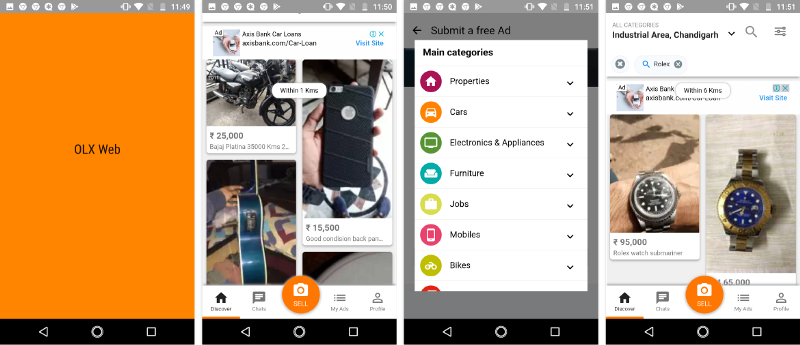
OLX is one of the biggest online characterized advertisements platforms in India. It fills in as a commercial center to associate purchaser and vendor of utilized merchandise and enterprises.
To give quick and straightforward service to its users, OLX chose to create a Progressive Web App for their mobile web. Subsequently, they have seen some prominent upgrades.
Results
- 23% less time until a page is intelligent
- 80% lower ricochet rates
- 146% higher CTR on Ads
- 250% more re-engagement
After this, I am going to tell you the next one which is –
Alibaba
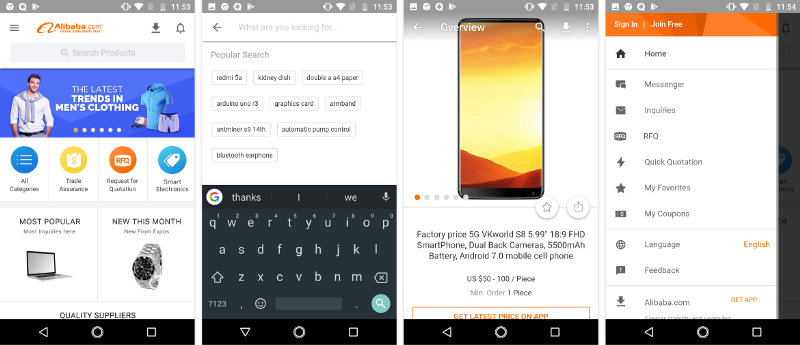
Alibaba.com is the world’s most significant online B2B exchanging gateway. It serves in 200+ nations and areas. They needed a fast and simple solution to carry on the exchanges for their users.
Obliging the users to download a native application was impossible for them as the mobile web users liked to remain inside the program. In this way, they built up the PWA to give application like involvement to the web users.
Results
- 76% higher transformations crosswise over programs
- 4X higher connection rate from Add to home screen
- 14% all the more month to month dynamic users on iOS; 30% on Android
So, I was as of late asked by a customer who is keen on Progressive Web Apps. They got some information about Progressive Web Apps versus native applications.
I’m burnt out on this confining by and large and am impervious to investing much energy contrasting Progressive Web Apps with native applications. I think Progressive Web Apps are an easy decision for general organizations.
So give me a chance to exhibit a basic case for Progressive Web Apps utilizing a progression of explanations that I accept even native application engineers would concur with.
-
Not every User will have your native application installed
This ought to be incredibly evident for general organizations. Potential users don’t have your application. Existing users might not have your application introduced.
Indeed, even those users who have your application introduced may not be on the gadget where they added it.
There is a substantial gathering of people of individuals getting to the mobile web that you shouldn’t disregard. Comscore found that “Mobile web gatherings of people are nearly 3x the size and becoming 2x as quick as application crowds.”

-
You should provide a secure environment for your customers
In case you’re gathering Visas or touchy data, this is an absolute necessity. There are great contentions to scramble everything on the web.
The new program includes, and even more seasoned ones like geolocation, presently require SSL. Google as of late reported that they would begin cautioning users about native that don’t utilize HTTPS.
Running your website under HTTPS is the primary prerequisite of Progressive Web Apps
-
You should provide a faster web experience for web customers
DoubleClick as of late distributed an examination that found that “53% of mobile site visits have relinquished if pages take longer than 3 seconds to stack.” Walmart discovered that3:
- For each 1 second of progress, they encountered up to a 2% expansion in changes
- For each 100 ms of development, they developed steady income by up to 1%
To put it plainly, the quicker your site is, the more probable you are to have glad users and get more cash-flow.
Progressive Web Apps are quick. The Washington Post’s Progressive Web App stacks new pages in under a second.

-
Your web customers would benefit from an offline experience
Our data networks are flaky and temperamental—, especially on mobile gadgets. Giving a disconnected ordeal implies that individuals can keep on utilizing your application notwithstanding when the system disappoints them.
Uplifting news! The mystery sauce that Progressive Web Apps use to make websites exceptionally quick is that they store resources disconnected.
So in case you’ve achieved #3 above, you’re more than halfway towards offline help.

-
Your web users might benefit from push notifications
In case you’re eBay, offering web guests the alternative to getting a message pop-up five minutes before the closeout closures would be a significant win.
Only one out of every unique business will have the utilization for web pop-up messages, yet for those that do, they can upgrade a web involvement and energize user engagement.

-
You can create a text file and some icons
All that is left to do is to make a show record that references symbols for the home screen. If you’ve figured out how to do the past four stages, this will be simple.
Progressive Web Apps make sense
Progressive Web Apps versus native is the wrong inquiry because each progression on the way to a Progressive Web App bodes well individually, independent of what an organization does with their native applications.
Not the majority of your users will have your application introduced. For the individuals who visit using the web, you are furnishing them with better experience will make them more joyful and produce more income for your business.
When fabricating an application, you, for the most part, have a decision between Native, Web, and Hybrid. Native apps are grown explicitly for one mobile working framework, similar to Android or iOS. That is the reason they cost a considerable amount to create and keep up.
Web applications are merely further developed web destinations, i.e., they offer specific usefulness, yet it’s everything conveyed using the Internet. Crossbreed applications are a blend between the other two and go through the program yet also store a few information on the gadget.
And after that, we have cross-platform applications. Cross-platform applications are native applications that have created for different working frameworks without a moment’s delay.
Rather than building native apps for every Android and iOS, a single cross-platform application can be sent on both. This enables organizations to spare a ton of cash on development and application upkeep costs.
There are numerous kinds of cross-platform applications, yet two of the most mainstream are PWA and React Native applications. Every its favorable circumstances and detriments; we should investigate every one separately to enable you to settle on a decision.
What Are Progressive Web Apps
Progressive Web Apps are further growth in web applications. They utilize the propelled abilities of programs. You can install the PWAs on the gadget and can run disconnected. Users like PWAs because they load a lot quicker contrasted with web applications or websites.
Organizations acknowledge PWAs because they are responsive and can fit on any mobile gadget, work area, or tablet.
PWAs are safe and secure because of the security conventions they utilize and discoverable because the user doesn’t need to discover them through an application store; however, download it straightforwardly from a website.
Likewise, because PWAs are websites, users can share them as URLs and web crawlers can find and list them.
What Are React Native Apps
React-Native is a product structure that utilizes a chain of command of UI segments to fabricate JavaScript code. It permits building mobile applications with a native look and feels using JavaScript. It will empower making a single application for the two iOS and Android and permits infusing some native code.
The disadvantages are that React Native is an open-source system; it’s still new. In the meantime, regardless it needs some native language to be completely useful on both Android and iOS.
Would it be advisable for you to Choose PWA or React Native?
Both PWAs and React Native are less expensive products to create contrasted with native applications, yet there are a few variables to consider while picking between the two.
While React Native permits constructing native applications, despite everything you need native engineers for every Android and iOS, native engineers should give the code to enable access to the camera, accelerometer, just as empower pop-up messages.
Well, PWAs don’t take into account the application to be incorporated into an application store. You’ll need to depend on your website or web application users to download it. Additionally, they are a lot more agreeable and less expensive to fabricate contrasted even with React Native applications.
Subsequently, if your business as of now has a website that is prominent among your users, PWAs are the ideal approach. If you can bear the cost of a somewhat greater spending plan and need an application that is nearer to native, at that point React-Native.
React-Native is likewise a fantastic methodology for new businesses that are hoping to construct a Minimum Viable Product before propelling a full-scale native application.
If you are as yet uncertain about which to pick, connect with our product development group for a brisk counsel, where we will introduce the favorable circumstances and detriments of both PWA and React Native applications custom fitted to your particular task.
Conclusion
Progressive Web Apps have immense potential and are evolving the mobile web scene. Time will decide whether PWAs will take over a native mobile app or not, but it has created its space in the mobile web. Even the trends show that the community is accepting this PWAs warm-heartedly.
In business what’s dangerous is not to evolve.
It could be a wise decision to accept the changes at the right time for the maximum benefit.
Hope you will get some benefits by reading it. If you are looking forward to enhancing your mobile web experience we can develop a reliable, swift and lightweight progressive web app for your business. ChromeInfotech provides premium web app development services using the latest JavaScript technologies such as AngularJS, React-native, and PHP technology. Feel free to contact us anytime!
We are a leading software and mobile app development company, and we provide an immense solution for your next generation PWAs. If you are looking to make your product a hit, at the point, ChromeInfotech is here to assist you and furnishes you with the significant amount of information and technologies.
If I have missed anything in this post or you have any suggestions or recommendations to include in this blog, please share your points in the comment section. We would love to add that information’s in our post.
Thanks for reading.


 +1 (512) 3331-934
+1 (512) 3331-934 +44 (161) 8188-928
+44 (161) 8188-928
